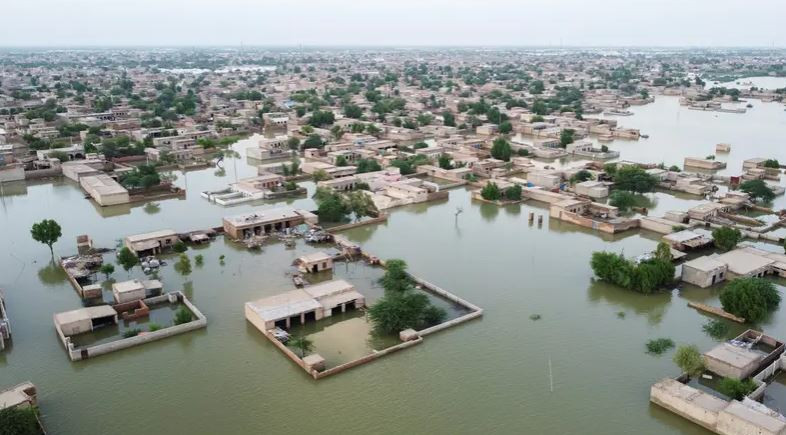
Pakistan is in the midst of perhaps the worst ‘natural’ disaster. According to the National Disaster Management Authority (NDMA), over 1,000 people are dead, more than 30 million people are displaced and nearly a million homes have been partially or completely destroyed. The scale of this disaster is many times greater than that of the 2010 floods which were riverine floods.
As a result of these unprecedented monsoon rains, nearly 116 districts across Pakistan have been severely affected, and the government has declared 66 districts as ‘calamity hit’.
Damage to infrastructure has further aggravated the humanitarian situation, as partial or complete destruction of over 3,000km of roads and 145 bridges impedes the ability of people to access markets or essential services. Government’s initial estimate of damage to the economy is around US$10 billion (3% of GDP). While no further official estimates are out yet; however, various sources have claimed a destruction to the tune of $20-25 billion.
The biggest impact is on agriculture sector. More than 800,000 livestock – a critical source of sustenance and livelihoods for many families – have perished. An estimated 2 million acres of crops have also been damaged, including important cash crops (cotton, rice, sugar) and essential foods and vegetables. The losses to the agriculture sector are significant, with estimates of 40% loss to cotton crop and 70% to rice crops.
The losses in agriculture sector will have significant multiplier effect. Based on analytical work carried out by the Bank of Punjab research team, we estimate that the total contribution of agriculture sector to the national GDP (at current prices) is 46.4%. This includes indirect contribution of the forward and backward linkages of agriculture sector with manufacturing and services and rural households spending. We estimate the agriculture sector multiplier of 1.8x to the GDP, meaning that a $2 billion loss in the agriculture sector will translate into a $3.6 billion loss to the GDP.
The other major consequence of losses to agriculture will be on poverty levels. HIES 2019 data shows that 3/4th of the extreme poor (ie, households living below Rs1,888 – 50% of the calculated poverty line) live in rural areas, and depend on agriculture livelihoods. There is a strong correlation between production of major crops and poverty. In 2011, crop sector output fell 12.6% as a result of massive flooding that destroyed crops and also caused loss of livestock. Poverty incidence recorded an increase of 1%, the only recorded period where poverty incidence increased.
Hence, impact on economy of the damage caused by the floods will be significantly higher than what current market estimates suggest. We are likely to see GDP growth slowing down further to around 2%, against the current IMF estimates of 3.5%. In this fast evolving scenario, our policy response must be calibrated towards the changing ground realities.
Reprioritise the FY2023 budget
The federal and provincial governments need to reprioritise the FY2023 budget allocations, in particular the PSDP and ADP expenditures for relief and rehabilitation work in the flood affected districts. Additional expenditure requirements need to be agreed in consultation with the IMF. During the 2020 Covid pandemic, IMF agreed to a Rs800 billion budget ‘adjustor’. In effect, the primary deficit targets were calculated excluding the Covid specific expenditure. The adjustor will give governments space to cater to emergency response and reconstruction activity.
Debt relief
Pakistan has benefitted from the G-20 Debt Service Suspension Initiative (DSSI) framework in the aftermath of Covid pandemic. Pakistan is the largest beneficiary of this programme, with an estimated $3.7 billion of debt suspended or rescheduled under the DSSI since 2020.
Government needs to look into expanding this initiative beyond the two-year timeline, targeting a 10-year suspension of these debt repayments. The UN 2022 Financing for Sustainable Development Report recommends urgent action to reactive the DSSI for another two years and reschedule maturity for up to five years. A new global push led by UN and G20 countries will be the most effective way for Pakistan to deal with its short-term debt liabilities.
Rapid financing facility – IMF
The UN 2022 report also calls to expand access to Rapid Financing Instruments for all developing countries. Pakistan must also explore the option to access the IMF Rapid Financing Instrument (RFI), similar to $1.4 billion facility utilised in 2020 as a result of the Covid pandemic.
Having said that fiscal challenges aside, the biggest impediment could potentially be on the capacity front. We would seriously be hampered in terms of available bodies and skills to execute massive work of reconstruction and more so rehabilitation. This aspect must also be kept in perspective while calibrating the real impact on the economy of this catastrophe.
In the end, would like to conclude by acknowledging the national spirit of our great nation. Despite difficult economic realities, they have again stepped up at this time of need. The response of federal and provincial governments, civil society and private sector is beyond expectations. We at the Bank of Punjab are witnessing firsthand the tremendous response generated by the calls to raise funds for the flood affected families and have raised over Rs2 billion hitherto in its various flood relief accounts.
As an institution, BOP is stepping up its CSR activities and has made arrangements whereby volunteering employees will be trained to build shelters and help in rehabilitation of the affected communities across the country. The bank will bear all the costs. We’re proud to be the first bank to extend relief to the small farmers by extending their loan repayments terms for a period of one year.
Zafar Masud is the President and CEO and Sayem Ali is the Chief Economist, The Bank of Punjab
Published in The Express Tribune, September 19th, 2022.
Like Business on Facebook, follow @TribuneBiz on Twitter to stay informed and join in the conversation.






1730793476-0/bella-(1)1730793476-0-165x106.webp)










1730706072-0/Copy-of-Untitled-(2)1730706072-0-270x192.webp)
COMMENTS
Comments are moderated and generally will be posted if they are on-topic and not abusive.
For more information, please see our Comments FAQ